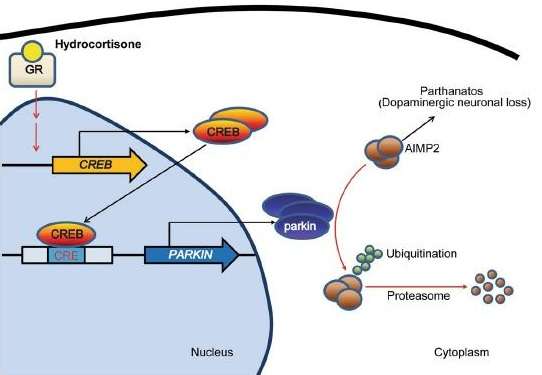Team identifies mechanism of dopaminergic neuronal death inhibition using stress hormone cortisol

DGIST's research team has found a candidate substance that can prevent and cure Parkinson's disease. By using this substance, the team also has identified the mechanism of dopaminergic neuronal death inhibition.
Parkinson's disease is a neurological degenerative brain disease caused by the death of dopaminergic neurons in the middle cerebral blood. It is a disease with high incidence in the population over the age of 60 and the symptoms are body tremor and stiffness, slow motion, posture instability, etc.
It is known that mutation or low expression of parkin protein, a part of the system that hydrolyzes intracellular proteins, accelerates the accumulation of toxic proteins that must be removed in cells and induces dopaminergic neuronal cell death and Parkinson's disease. Currently, Parkinson's disease is classified as a rare incurable disease, one of the Korean government's four major target serious illnesses. However, there are no drugs to prevent the death of dopaminergic neurons.
The senior researcher Yoon-Il Lee's research team and Professor Yunjong Lee's research team have conducted studies on the development of candidate substances to cure Parkinson's disease and their mechanisms. The researchers performed a high-throughput screening method to identify drug candidates that promote dopaminergic neuronal cell activation by inducing the expression of the parkin protein, the cell protection gene that can inhibit the death of dopaminergic neurons.
As a result, it has been identified that cortisol, known as a stress hormone, induces the expression of the parkin protein and prevents dopaminergic neuronal death by eliminating the accumulation of cell death factors through ubiquitin proteasome system.
In addition, the team has demonstrated the mechanism by which cortisol induces the expression of the parkin protein and CREB transcriptional regulator through the hormone receptor that regulates the expression of the parkin protein. The study, using cellular and animal models, also shows that cortisol can be used as a therapeutic agent for degenerative Parkinson's disease.
The senior researcher Yoon-Il Lee stated "The significance of this study is that it has identified that the expression of parkin protein induced by a moderate level of the stress hormone cortisol could be an important factor in maintaining the viability of dopaminergic neurons. We will continue to conduct follow-up studies such as clinical studies so that the Parkinson's disease will be curable in the future."
More information: Sangwoo Ham et al, Hydrocortisone-induced parkin prevents dopaminergic cell death via CREB pathway in Parkinson's disease model, Scientific Reports (2017). DOI: 10.1038/s41598-017-00614-w

















